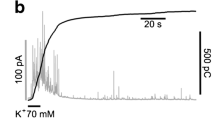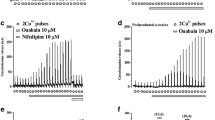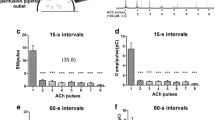Abstract
In order to investigate the cellular mechanisms involved in amylase release in response to stimulation with short-chain fatty acids, changes in intracellular calcium concentration ([Ca2+]i), membrane current and amylase release were measured in pancreatic acinar cells of sheep. Both octanoate and acetylcholine raised [Ca2+]i in acinar cells in a concentration-dependent manner. The rise in [Ca2+]i in response to the stimulation with octanoate (10 mmol·l-1) was reduced in a medium without CaCl2, but was markedly enhanced by reintroduction of CaCl2 into the medium up to 2.56 mmol·l-1. Perfusion of the cells with a medium containing octanoate (5 mmol·l-1) or acetylcholine (0.5 μmol·l-1) immediately raised inward current across the cell membrane at a holding-membrane potential of-30 mV. The inward current became greater as the holding potential became more negative. The equilibrium potential was 1.8 mV and 3.9 mV for octanoate and acetylcholine, respectively, being consistent with that for Cl-. Although intracellular application of octanoate through a patch-clamp pipette also raised inward current after several minutes in some cells (4 out of 12), this possibility was significantly smaller than that for extracellular application. In other cells, even though the intracellular application of octanoate did not cause an increase in current, it always caused responses immediately after introduction of the fatty acid into the medium. Stimulation with fatty acid as well as acetylcholine raised amylase release in a concentration-dependent manner in cells dispersed from tissue segments with crude collagenase and trypsin inhibitor. Without trypsin inhibitor, crude collagenase significantly and selectively reduced the octanoate (10 mmol·l-1)-induced amylase release. Dispersion with crude collagenase and trypsin significantly reduced both responses induced by octanoate and acetylcholine (5.5 μmol·l-1). We conclude that fatty acids and acetylcholine increase [Ca2+]i, which consequently evokes a rise in transmembrane ion (Cl-) conductance and amylase release, and that trypsin-sensitive protein(s) in the cell membrane are involved in secretory processes activated by stimulation with fatty acids in ovine pancreatic acinar cells.
Similar content being viewed by others
Abbreviations
- ACh :
-
acetylcholine
- SCFA :
-
short-chain fatty acid(s)
- fura-2/AM :
-
fura-2-acetoxymethyl ester
- GTP-γS :
-
guanosine-5′-o-(3-thiodiphosphate)
References
Amsterdam A, Jamieson JD (1972) Structural and functional characterization of isolated pancreatic cells. Proc Natl Acad Sci USA 69:3082–3032
Berrige MJ (1991) Cytoplasmic calcium oscillations: a two pool model. Cell Calcium 12:63–72
Ekokoski E, Forss L, Tornquist K (1994) Inhibitory action of fatty acids on calcium fluxes in thyroid FRTL-5 cells. Mol Cell Endocrinol 103:125–132
Furukawa T, Fan Z, Sawanobori T, Hiraoka M (1993) Modification of the adenosine 5′-triphosphate-sensitive K+ channel by trypsin in guinea-pig ventricular myocytes. J Physiol (Lond) 466: 707–726
Grynkiewicz G, Poemie M, Tsien RY (1985) A new generation of Ca2+ indicators with greatly improved fluorescence properties. J Biol Chem 260:3440–3450
Harada E (1985) Comparison of pancreatic digestive enzyme secretion induced by volatile fatty acids in mice, Japanese field voles and goats. Comp Biochem Physiol 81A:539–543
Harada E, Kato S (1983) Effect of short-chain fatty acids on the secretory response of the ovine exocrine pancreas. Am J Physiol 24:G284-G290
Kasai H, Augustine GJ (1990) Cytosolic Ca2+ gradients triggering unidirectional fluid secretion from exocrine pancreas. Nature 348:735–738
Kato S, Katoh K, Barej W (1991) Regulation of exocrine pancreatic secretion in ruminants. In: Tsuda T et al. (eds) Physiological aspects of digestion and metabolism in ruminants. Academic Press, San Diego, pp 89–109
Katoh K (1995) Effects of short-chain fatty acids on exocrine and endocrine pancreatic secretion. In: Cummings JH et al. (eds) Physiological and clinical aspects of short-chain fatty acids. Cambridge University Press, Cambridge, pp 223–231
Katoh K, Tsuda T (1984) Effects of short-chain fatty acids on acinar cells of the exocrine pancreas in sheep. J Physiol (Lond) 356: 479–489
Katoh K, Tsuda T (1985) Effects of secretagogues on membrane potential and input resistance of pancreatic acinar cells of sheep. Res Vet Sci 38:250–251
Katoh K, Tsuda T (1987) Effects of intravenous injection of butyrate on the exocrine pancreatic secretion in guinea pigs. Comp Biochem Physiol 87A:569–572
Katoh K, Wakui M (1993) Short-chain fatty acids (SCFAs) increase cytosolic calcium concentrations, inward current and amylase release in pancreatic acinar cells. Short Chain Fatty Acids (Falk Symposium No. 73) Abstract No. B14
Katoh K, Yajima T (1989) Effects of butyric acid and analogues on amylase release from pancreatic segments of sheep and goats. Pflügers Archiv 413:256–260
Merrit JE, Armstrong WP, Benham CD, Hallam TJ, Jacob R, Jaxa-Chamiec A, Leigh BK, McCarthy SA, Moores KE, Rink TJ (1990) SK&F 96365, a novel inhibitor of receptor-mediated calcium entry. Biochem J 271:515–522
Ohbo M (1991) Stimulatory effects of fatty acids on amylase release from ovine and rodent pancreatic tissues and cells. Masters dissertation, Tohoku University, Sendai, Japan
Ohbo M, Katoh K, Sasaki Y (1989) Effects of short-, medium- and long-chain fatty acids on amylase release from pancreatic segments of rats. Asian-Australasian J Anim Sci 2:193–194
Ohbo M, Katoh K, Sasaki Y (1996) Effects of saturated fatty acids on amylase release from exocrine pancreatic segments of sheep, rats, hamsters, field voles and mice. J Comp Physiol (in press)
Ordway RW, Singer JJ, Walsh JV (1991) Direct regulation of ion channels by fatty acids. Trend Neurosci 14:96–100
Osipchuk YV, Wakui M, Yule DI, Gallacher DW, Petersen OH (1990) Cytoplasmic Ca2+ oscillation evoked by receptor stimulation, G-protein activation, internal application of inositol trisphosphate or Ca2+: simultaneous microfluorimetry and Ca2+-dependent Cl- current recording in single pancreatic acinar cells. EMBO J 9:697–704
Petersen OH (1992) Stimulus-secretion coupling: cytoplasmic calcium signals and the control of ion channels in exocrine acinar cells. J Physiol (Lond) 448:1–51
Petersen OH, Wakui M (1990) Oscillating intracellular Ca2+ signals evoked by activation of receptors linked to inositol lipid hydrolysis: mechanism of generation. J Membr Biol 118:93–105
Proks P, Ashcroft FM (1993) The effects of trypsin on ATP-regulated K+ channels from pancreatic β-cells isolated from the mouse. J Physiol (Lond) 459: 240P
Stevens CE (1988) Comparative physiology of the vertcbrate digestive system. Cambridge University Press, Cambridge, pp 159–190
Stremmel W, Diede HE (1989) Fatty acid uptake by human cell lines represents a carrier-mediated uptake process. Biochim Biophys Acta 1013:218–222
Thevenod F, Dehlinger-Kremer M, Kremmer TP, Christian A-L, Potter BVL, Schulz I (1989) Characterization of inositol 1,4,5-bisphosphate-sensitive and-insensitive nonmitochondrial Ca2+ pools in rat pancreatic acinar cells. J Membr Biol 109:173–179
Wakui M, Potter BVL, Petersen OH (1989) Pulsatile intracellular calcium release does not depend on fluctuations in inositol trisphosphate concentration. Nature 339:317–320
Warnotte C, Gilon P, Nenquin M, Henquin J-C (1994) Mechanisms of the stimulation of insulin release by saturated fatty acids. Diabetes 43:703–711
Watson AJM, Brennan EA, Farthing MJG, Fairclough PD (1991) Acetate uptake by intestinal brush border membrane vesicles. Gut 32:383–385
Wrong OM (1995) Definition and history. In: Cummings JH et al. (eds) Physiological and clinical aspects of short-chain fatty acids. Cambridge University Press, Cambridge, pp 1–14
Zar JH (1984) Biostatistical analysis, 2nd edn. Prentice-Hall, Englewood Cliffs
Author information
Authors and Affiliations
Corresponding author
Additional information
Communicated by I.D. Hume
Rights and permissions
About this article
Cite this article
Katoh, K., Ohbo, M. & Wakui, M. Octanoate increases cytosolic Ca2+ concentration and membrane conductance in ovine pancreatic acinar cells. J Comp Physiol B 166, 369–374 (1996). https://doi.org/10.1007/BF02336919
Accepted:
Issue Date:
DOI: https://doi.org/10.1007/BF02336919




